Draw 2 Keyword Pictures And Write The Letter
Emergent writing is young children's first attempts at the writing process. Children as young as 2 years old begin to imitate the act of writing by creating drawings and symbolic markings that represent their thoughts and ideas (Rowe & Neitzel 2010; Dennis & Votteler 2013). This is the beginning of a series of stages that children progress through as they learn to write (see "Stages of Emergent Writing"). Emergent writing skills, such as the development of namewriting proficiency, are important predictors of children's future reading and writing skills (National Center for Family & Literacy 2008; Puranik & Lonigan 2012).
Teachers play an important role in the development of 3- to 5-year-olds' emergent writing by encouraging children to communicate their thoughts and record their ideas (Hall et al. 2015). In some early childhood classrooms, however, emergent writing experiences are almost nonexistent. One recent study, which is in accord with earlier research, found that 4- and 5-year-olds (spread across 81 classrooms) averaged just two minutes a day either writing or being taught writing (Pelatti et al. 2014). This article shares a framework for understanding emergent writing and ties the framework to differentiating young children's emergent writing experiences.
Understanding emergent writing
Researchers and educators often use the term emergent literacy to define a broad set of language and literacy skills focused primarily on the development and significance of emergent reading skills. To better understand writing development—and to support teachers' work with young children—researchers have proposed a framework to explain emergent writing practices (Puranik & Lonigan 2014). The framework is composed of three domains: conceptual knowledge, procedural knowledge, and generative knowledge.
Conceptual knowledge includes learning the function of writing. In this domain, young children learn that writing has a purpose and that print is meaningful (i.e., it communicates ideas, stories, and facts). For example, young children become aware that the red street sign says Stop and the letters under the yellow arch spell McDonald's. They recognize that certain symbols, logos, and markings have specific meanings (Wu 2009).

Procedural knowledge is the mechanics of letter and word writing (e.g., name writing) and includes spelling and gaining alphabet knowledge. Learning the alphabetic code (including how to form letters and the sounds associated with each letter) is an essential component of gaining procedural knowledge. Children benefit from having multiple opportunities throughout the day to develop fine motor skills and finger dexterity using a variety of manipulatives (e.g., magnetic letters, pegboards) and writing implements.
Generative knowledge describes children's abilities to write phrases and sentences that convey meaning. It is the ability to translate thoughts into writing that goes beyond the word level (Puranik & Lonigan 2014). During early childhood, teachers are laying the foundation for generative knowledge as children learn to express themselves orally and experiment with different forms of written communication, such as composing a story, writing notes, creating lists, and taking messages. Children can dictate words, phrases, or sentences that an adult can record on paper, or they can share ideas for group writing.
Developing conceptual, procedural, and generative knowledge of writing
Children gain knowledge of and interest in writing as they are continually exposed to print and writing in their environment. There are multiple strategies teachers can use to scaffold children's writing, such as verbally reminding children to use writing in their classroom activities and providing appropriate writing instructions (Gerde, Bingham, & Wasik 2012). By being aware of children's current fine motor abilities and their progress in emergent writing, teachers can use a mix of strategies to foster growth in each child's zone of proximal development (Vygotsky 1978).
Practicing name writing
One of the first words children usually learn to write is their first name (Both-de Vries & Bus 2008). Name writing increases children's conceptual and procedural knowledge. Names are meaningful to children, and preschoolers typically are interested in learning to write the letters in their name, especially the first letter (Both-de Vries & Bus 2008). Namewriting proficiency provides a foundation for other literacy knowledge and skills; it is associated with alphabet knowledge, letter writing, print concepts, and spelling (Cabell et al. 2009; Drouin & Harmon 2009; Puranik & Lonigan 2012).
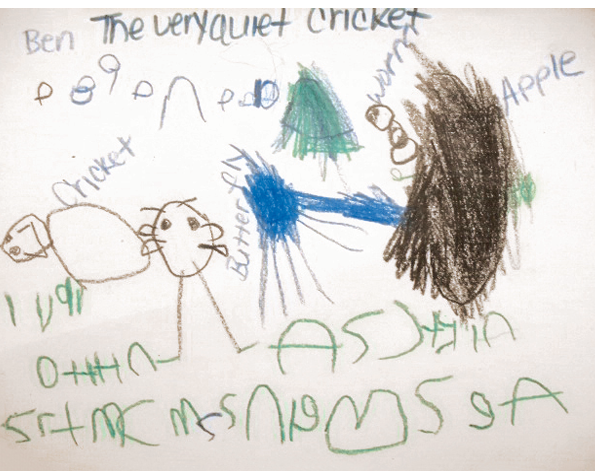
Preschoolers benefit from daily writing experiences, so it is helpful to embed writing in the daily routine, such as having children write (or attempt to write) their names at sign-in and during choice times. Be sensitive to preschoolers' varying levels of fine motor skills and promote the joy of experimenting with the art of writing, regardless of a child's current skill level. Encourage invented spelling (Ouellette & Sénéchal 2017) and attempts at writing letters or letter-like symbols.
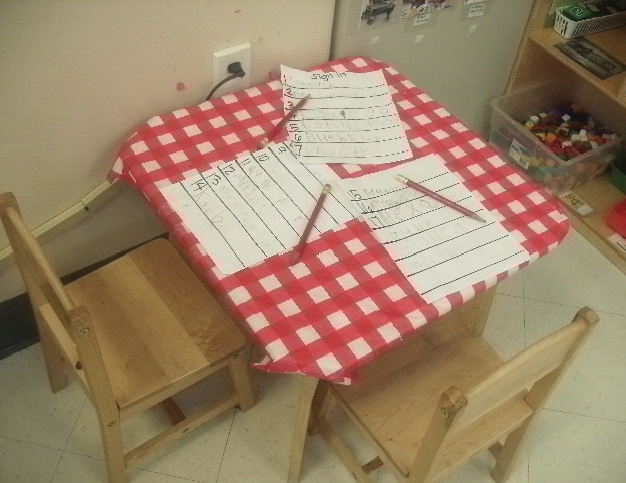
As Ms. Han's preschoolers enter the classroom, they sign in, with parental support, by writing their names on a whiteboard at the classroom entrance. Children in Ms. Noel's classroom go to a special table and sign in as they enter the room. Ms. Patel instructs her preschoolers to answer the question of the day by writing their names under their chosen answers. Today, the children write their names to answer the question "What are your favorite small animals—piglets, ducklings, or kittens?" Juan and Maria help their friends read the question and write their names under the appropriate headings. Pedro writes Pdr under the piglets heading, Anthony writes his complete name under ducklings, and Tess writes the letter T under kittens. In Mr. Ryan's class, children write their names during different activities. Today, children sign in as they pretend to visit the doctor in one learning center and sign for a package delivery in another. Meanwhile, Tommy walks around the room asking other preschoolers to sign their names in the autograph book he created in the writing center.
Tips for teachers
- Develop a sign-in or sign-out routine that allows children to write, or attempt to write, their names each day. In some classrooms, or for some children, the routine may begin with writing the first letter instead of the whole name or with scribbling letterlike symbols.
- Use peer helpers to aid children with the name-writing process.
- Model writing your name and promote name-writing activities in several centers through the day, such as having children sign their name as they write a prescription or when they complete a painting.
Learning from teacher modeling
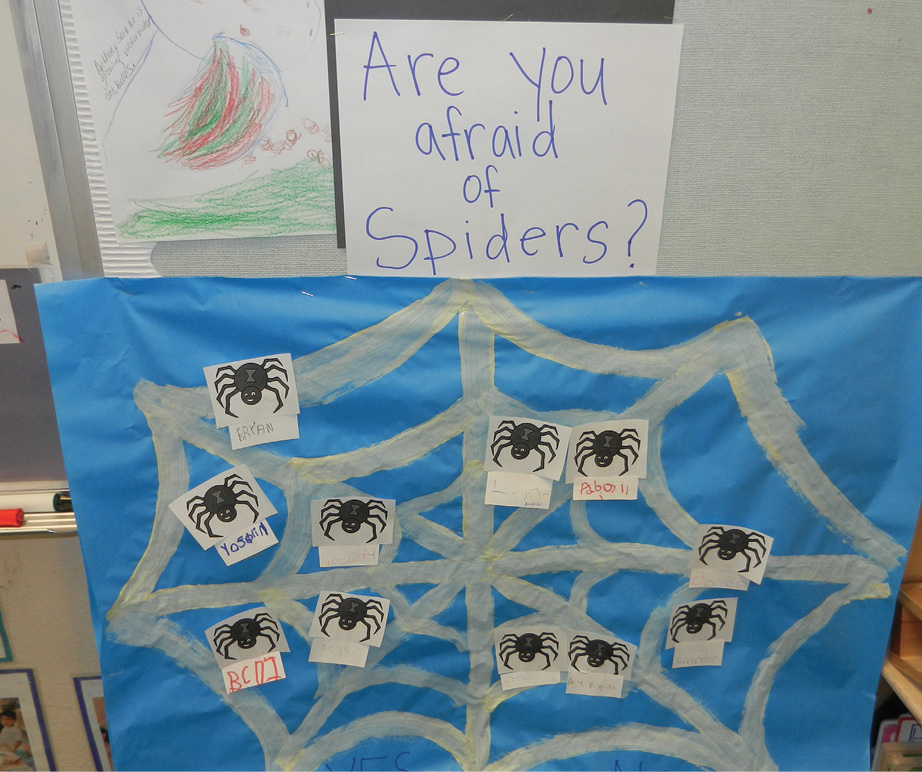 Children benefit from teachers modeling writing and from opportunities to interact with others on writing projects. Teachers can connect writing to topics of interest, think aloud about the process of composing a message (Dennis & Votteler 2013), and explain how to plan what to write (e.g., choosing words and topics, along with the mechanics of writing, such as punctuation). Children struggling to attain early writing skills benefit from explicit teaching (Hall et al. 2015). Teach children that letters create words and words create sentences. Use environmental print (e.g., labels, charts, signs, toy packaging, clothing, and billboards) to help children realize that print is meaningful and functional (Neumann, Hood, & Ford 2013). These types of activities build both conceptual and procedural knowledge.
Children benefit from teachers modeling writing and from opportunities to interact with others on writing projects. Teachers can connect writing to topics of interest, think aloud about the process of composing a message (Dennis & Votteler 2013), and explain how to plan what to write (e.g., choosing words and topics, along with the mechanics of writing, such as punctuation). Children struggling to attain early writing skills benefit from explicit teaching (Hall et al. 2015). Teach children that letters create words and words create sentences. Use environmental print (e.g., labels, charts, signs, toy packaging, clothing, and billboards) to help children realize that print is meaningful and functional (Neumann, Hood, & Ford 2013). These types of activities build both conceptual and procedural knowledge.
When Ms. Noel sits with the children during snack, she talks with them about the different foods they like to eat. Ben tells her he likes chicken. She writes on a small whiteboard, "Ben likes chicken." She asks Ben to read the phrase to a friend. Later, Ben writes the phrase himself.
Mr. Ryan conducts a sticky note poll. He creates a giant spiderweb and writes the question, "Are you afraid of spiders? Yes or no." He gives the children sticky notes so each can write either yes or no and then place it on the giant web. This activity is followed by a discussion of spiders.
Tips for teachers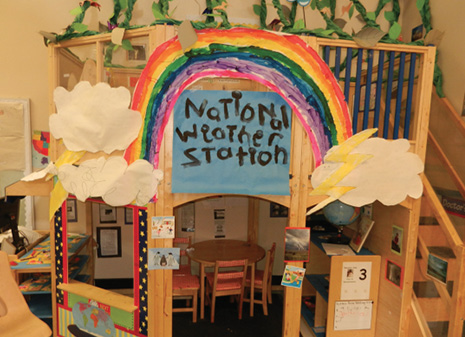
- Explicitly model writing by showing the writing process to children and thinking aloud while writing. Instead of writing the question of the day or the morning message before the children arrive, write it in front of them.
- Label specific items in the room, and draw children's attention to the written words. Write out functional phrases on signs related to routines, such as "Take three crackers" or "Wash hands before eating," then read and display the signs.
- Have the children paint large classroom signs related to themes being explored, such as the National Weather Station, Snack Bar, Public Library, or Entomology Center.
Writing throughout the day
Preschoolers enjoy experimenting with the writing process. Emergent writing experiences can include spontaneous writing during center time and teacherguided writing activities. Writing can become an important component of every learning center in the preschool classroom (Pool & Carter 2011), especially if teachers strategically place a variety of writing materials throughout the classroom and offer specific guidance on using the materials (Mayer 2007). (See "Learning Centers: Adding Meaningful Writing Materials and Literacy Props.")

Teachers can intentionally promote peer-to-peer scaffolding by having children participate in collaborative writing experiences. Read-alouds are also a wonderful means of promoting writing; there are a number of stories that feature characters in books writing letters, stories, messages, and lists (see "Books That Promote Writing"). Model writing stories, making lists, or labeling objects, and then encourage your preschoolers to write a response letter to a character in a story, create their own storybook, or write a wish list or a shopping list. Such a variety of writing experiences will also build their generative knowledge of writing.

Ms. Han has strategically placed a variety of writing materials throughout the classroom—a scientific journal in the discovery area so children can record their observations and ideas; a graph paper notebook in the block area for drafting blueprints with designs and words; and a receipt book, paper, and markers in the dramatic play area. Savannah sits at the discovery center looking at a classroom experiment. Ms. Han asks, "Savannah, could you write about your observations in our science journal?" Savannah begins writing in the journal.
Three boys are playing in the block area. Ms. Han asks, "What are you building?" Marcus replies, "We are going to build a rocket ship." Ms. Han says, "Could you create a blueprint of your rocket and then build it?" The boys eagerly begin drawing a plan. Several children in the dramatic play center are drawing different types of flowers for a flower market. Ms. Han says, "In a flower market, signs tell customers what is for sale and how much it costs. Would you like to create some signs?" The children readily agree and start to create signs.
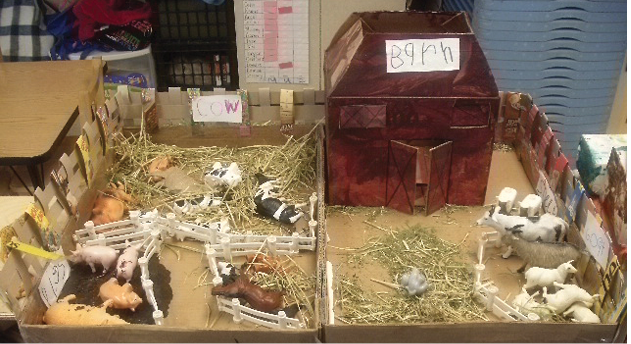 Tips for teachers
Tips for teachers
- Strategically place writing materials, such as sticky notes, small chalkboards, whiteboards, envelopes, clipboards, journals, stencils, golf pencils, markers, and various types, sizes, and colors of paper throughout the classroom.
- Provide specific teacher guidance to scaffold children's writing. While some children may be off and running with an open-ended question, others might be better supported if the teacher helps write their ideas—at least to get them started.
- Create writing opportunities connected to your current classroom themes or topics of interest. Involve the children in collaborative writing projects, such as creating a diorama after a farm visit and making labels for the different animals and the barn. With teacher support, the class could also develop a narrative to describe their farm visit.
Home–school connection
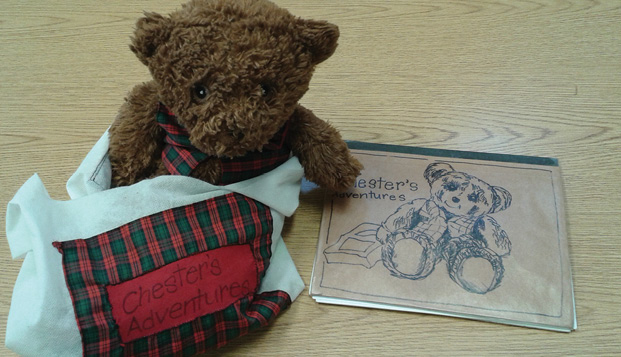 Both preschool writing instruction and home writing experiences are essential components of helping children develop writing skills. A major advantage of the home– school connection is that children see the value of what they learn in school when parents actively participate in the same type of activities at home. Teachers can encourage parents to display photos of their child engaged in writing activities at home and to share samples of their child's writing or drawings from home to inform instruction (Schickedanz & Casbergue 2009). To maximize parental involvement and support, teachers should be sensitive to the diversity of the families in their programs and be inclusive by promoting writing in children's home languages. These experiences can help promote children's conceptual, procedural, and generative knowledge.
Both preschool writing instruction and home writing experiences are essential components of helping children develop writing skills. A major advantage of the home– school connection is that children see the value of what they learn in school when parents actively participate in the same type of activities at home. Teachers can encourage parents to display photos of their child engaged in writing activities at home and to share samples of their child's writing or drawings from home to inform instruction (Schickedanz & Casbergue 2009). To maximize parental involvement and support, teachers should be sensitive to the diversity of the families in their programs and be inclusive by promoting writing in children's home languages. These experiences can help promote children's conceptual, procedural, and generative knowledge.
Ms. Noel wants to strengthen home–school connections with the families in her program. She decides to introduce the children to Chester (a stuffed teddy bear). She tells the children that Chester wants to learn more about what the children do at home and to go on some weekend adventures. She says, "Each weekend, Chester will travel home with a child in our class. During the time Chester stays at your house, take pictures of the activities you do with Chester and write about them in the Chester Weekend Adventures journal. At the beginning of the week, bring Chester and the journal back to school to share what you did. We will put Chester and the journal in the classroom library when he is not on a visit, so everyone can see where he has been." The children are excited about taking Chester home and writing about their adventures.
Tips for teachers
- Find writing opportunities that strengthen home–school connections. For example, encourage families to create books at home related to a particular theme or a specific topic. Invite children to share their books with the class and then add them to the library.
- Invite families to share the types of writing activities their children engage in at home. Encourage parents to establish routines that include writing lists, messages, stories, and letters.
- Give families postcards to mail to friends in other states and countries. Have them ask their friends to mail a reply to the preschool class. Create a display of the return messages and postcards.
Summary
Teachers play an important role in promoting emergent writing development by scaffolding writing activities that engage young children in building their conceptual, procedural, and generative knowledge. Writing can easily be embedded in daily routines as children write their names, engage in learning centers, practice writing for a purpose based on teacher and peer models, and contribute to group writing activities. Be intentional during interactions with children and incorporate best practices. Promote the development of emergent writing—and emergent literacy—by implementing purposeful strategies that encourage writing in the classroom and at home. Teachers who provide young children with a diverse array of early writing experiences lay the foundation for kindergarten readiness.
Authors' note: A special thanks to all of the teachers who participated in the Striving Readers Literacy Program and shared their literacy ideas. Thanks to Barbara Berrios for sharing the Chester Bear idea.
References
Both-de Vries, A.C., & A.G. Bus. 2008. "Name Writing: A First Step to Phonetic Writing? Does the Name Have a Special Role in Understanding the Symbolic Function of Writing?" Literacy Teaching and Learning 12 (2): 37–55.
Cabell, S.Q., L.M. Justice, T.A. Zucker, & A.S. McGinty. 2009. "Emergent Name-Writing Abilities of Preschool-Age Children with Language Impairment." Language, Speech, and Hearing Services in Schools 40 (1): 53–66.
Dennis, L.R., & N.K. Votteler. 2013. "Preschool Teachers and Children's Emergent Writing: Supporting Diverse Learners." Early Childhood Education Journal 41 (6): 439–46.
Drouin, M., & J. Harmon. 2009. "Name Writing and Letter Knowledge in Preschoolers: Incongruities in Skills and the Usefulness of Name Writing as a Developmental Indicator." Early Childhood Research Quarterly 24 (3): 263–70.
Gerde, H.K., G.E. Bingham, & B.A. Wasik. 2012. "Writing in Early Childhood Classrooms: Guidance for Best Practices." Early Childhood Education Journal 40 (6): 351–59.
Hall, A.H., A. Simpson, Y. Guo, & S. Wang. 2015. "Examining the Effects of Preschool Writing Instruction on Emergent Literacy Skills: A Systematic Review of the Literature." Literacy Research and Instruction 54 (2): 115–34.
Mayer, K. 2007. "Emerging Knowledge about Emergent Writing." Young Children 62 (1): 34–41.
National Center for Family Literacy. 2008. Developing Early Literacy: A Scientific Synthesis of Early Literacy Development and Implications for Intervention. Report of the National Early Literacy Panel. Washington, DC: National Institute for Literacy.
Neumann, M.M., M. Hood, & R.M. Ford. 2013. "Using Environmental Print to Enhance Emergent Literacy and Print Motivation." Reading and Writing 26 (5): 771–93.
Ouellette, G., & M. Sénéchal. 2017. "Invented Spelling in Kindergarten as a Predictor of Reading and Spelling in Grade 1: A New Pathway to Literacy, or Just the Same Road, Less Known?" Developmental Psychology 53 (1): 77–88.
Pelatti, C.Y., S.B. Piasta, L.M. Justice, & A. O'Connell. 2014. "Language- and Literacy-Learning Opportunities in Early Childhood Classrooms: Children's Typical Experiences and Within-Classroom Variability." Early Childhood Research Quarterly 29 (4): 445–56.
Pool, J.L., & D.R. Carter. 2011. "Creating Print-Rich Learning Centers." Teaching Young Children 4 (4): 18–20.
Puranik, C.S., & C.J. Lonigan. 2012. "Name-Writing Proficiency, Not Length of Name, Is Associated with Preschool Children's Emergent Literacy Skills." Early Childhood Research Quarterly 27 (2): 284–94.
Puranik, C.S., & C.J. Lonigan. 2014. "Emergent Writing in Preschoolers: Preliminary Evidence for a Theoretical Framework." Reading Research Quarterly 49 (4): 453–67.
Rowe, D.W., & C. Neitzel. 2010. "Interest and Agency in 2- and 3-Year-Olds' Participation in Emergent Writing." Reading Research Quarterly 45 (2): 169–95.
Schickedanz, J.A., & R.M. Casbergue. 2009. Writing in Preschool: Learning to Orchestrate Meaning and Marks. 2nd ed. Preschool Literacy Collection. Newark, DE: International Reading Association.
Vygotsky, L.S. 1978. Mind in Society: The Development of Higher Psychological Processes. Ed. & trans. M. Cole, V. John-Steiner, S. Scribner, & E. Souberman. Rev. ed. Cambridge, MA: Harvard University Press.
Wu, L.Y. 2009. "Children's Graphical Representations and Emergent Writing: Evidence from Children's Drawings." Early Child Development and Care 179 (1): 69–79.
Photographs: pp. 75, 76, 77, 78, 79, 80, courtesy of the authors; p. 74, © iStock
Draw 2 Keyword Pictures And Write The Letter
Source: https://www.naeyc.org/resources/pubs/yc/nov2017/emergent-writing
Posted by: linseymarban.blogspot.com

0 Response to "Draw 2 Keyword Pictures And Write The Letter"
Post a Comment